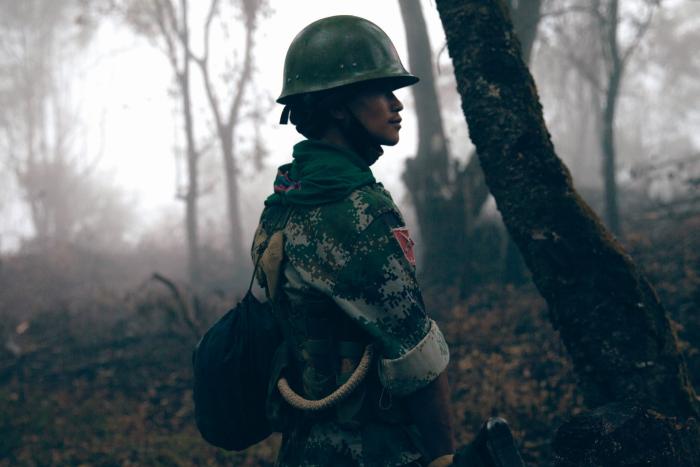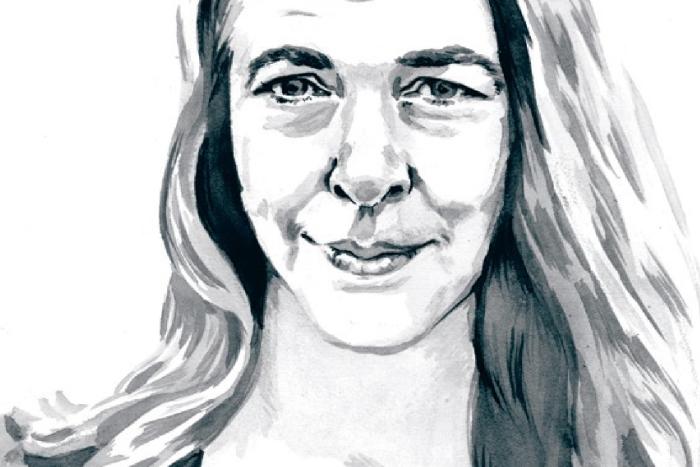In late December 2010, Gabriella Coleman was experiencing an academic strain of holiday frazzle. Rushing to finish a book on open-source hacker culture, the cultural anthropologist and scholar of digital activism was crushed by tenure-track deadlines. Visiting family on the West Coast at the time, she was also trying to balance family-time activities like board game nights with her work tracking a hacking operation that threatened to not only derail her writing schedule, but to change the course of her career.
At a time when Anonymous was better known to the world as a pitiless trickster troupe born from 4chan image boards of porn, gore, and LOLcats, a subsection of the group called AnonOps was engaging in something decidedly more political. They were attacking Internet piracy opponents, retaliating after a software company was purportedly hired by media interests to flood popular file sharing sites like Pirate Bay with unmanageable traffic. Targeting organizations such as the Motion Picture Association of America and the British Phonographic Industry, AnonOps participants would take down websites with distributed denial of service (DDoS) attacks—overwhelming them with waves of traffic via networks of virus-infected computers to the point of meltdown. The actions were charged with an activist fervour seemingly uncharacteristic of a group whose best-known antics at the time ranged in virtue from trolling the Church of Scientology to harassing an 11-year-old girl for making a couple of annoying YouTube videos.
By mid-December 2010, Operation Payback, as the project was called, had changed course entirely. They refocused on supporting WikiLeaks, in a now-infamous U.S. diplomatic cable dump, by DDoSing e-commerce companies that were blocking donations to the whistleblower non-profit. Glued to her laptop well into the night over that Christmas break, Coleman hung out in chat rooms, watching Anons vote and argue over carrying out DDoS attacks on the websites of companies including PayPal, MasterCard, and Visa.
“I was witnessing the first large-scale, populist, full-bodied online protest, and I was not going to miss it for the world, especially not for Settlers of Catan,” she writes of that holiday in Hacker, Hoaxer, Whistleblower, Spy. What followed was a whirlwind three years in which Coleman would watch Anonymous develop into a multifaceted activist force, and witness many of the micropolitics and internal struggles that come with those growing pains. Her documentation of that evolution in HHWS is as much a story about Anonymous (and not the only story, she stresses) as it is about her own experiences trying to understand—and translate for—the amorphous collective.
*
Coleman isn’t by any means the only person to gain access to Anonymous as a storyteller of some sort. When tech journalist Quinn Norton reviewed Forbes London bureau chief Parmy Olsen’s investigative book We Are Anonymous for Wired last year, she pointed out a core problem that she, Olsen, and others have encountered while reporting on the hyper-labyrinthine workings of the hacktivist collective. “Make no mistake, we have a role,” she wrote. “You just can’t not join. It’s impossible to not be part of the thing, when the thing uses the media to talk to itself.” That conversation has ranged from news websites being hacked in retaliation for stories perceived to be biased, to reporters posting a photo of themselves in tutus in exchange for information. Others have gained access to Anonymous’ more secretive branches such as LulzSec, which claimed responsibility for a series of high-profile security pranks that included posting fake stories to PBS’s website, stealing data from Sony’s PlayStation Network, and dumping documents from the Arizona Department of Public Safety online.
“I think it’s an interesting and unusual role, because not a lot of political movements adopt outsiders as a certain type of insider the way Anonymous did,” says Coleman, who moved from teaching at NYU to take up at McGill University in 2012 as the Wolfe Chair in Scientific and Technological Literacy. “On the other hand, the anthropological imperative is to become a participant. So in that sense all anthropologists go through what I went through.”
More than once in the book, these chat logs show the clusterfuck-reality of a group of strangers trying to plan actions that range from a theatrical YouTube manifesto to something more decidedly risky and illegal.
Unless speaking with a source face-to-face, conversations between Anons quoted in HHWS appear in their original form as chat room logs, a stylistic choice that may sometimes throw the reader for a loop—which is kind of the point. “It’s almost the only way to understand how weird the decision-making is in Anonymous,” says Coleman. “There’s norms and mechanisms for control, but the very medium itself”—ungoverned, prone to people speaking all at once and over each other—“also determines the thrust of decision making.” More than once in the book, these chat logs show the clusterfuck-reality of a group of strangers trying to plan actions that range from a theatrical YouTube manifesto to something more decidedly risky and illegal. The decision to DDoS PayPal, Visa, and MasterCard in retaliation for blocking donations to WikiLeaks is a good example of this weird type of emergent planning. Once a few individuals attacked PayPal’s blog in early December 2010 without notifying the larger Anonymous group—which wasn’t unusual since the Anonymous label is open for anyone’s use—the majority was left to decide whether or not to support it. Amid chat infighting about whether to vote on it or not, one Anon writes in all-caps, “ok the fuck, WHO THE FUCK IN HERE HAS ANY IDEA AT ALL?” while another logs in and takes responsibility for the original PayPal attack, calling it a personal side project. This declaration gets lost in the fray of messages as the majority of the chat room participants decide to take up the cause. Within a few days, nearly 7,800 people had logged into the Internet Relay Chat room to participate.
*
On October 30, 2014, the fallout from Operation Payback that hooked Coleman into four years of research came to something resembling an end when charges against 11 of the original 14 Anons arrested for DDoSing PayPal were dropped.
As a movement, Anonymous has come a long way since 2010. We’ve watched its members in some form or another get involved in the Tunisian Revolution, hack security firms, spark Occupy protests, and start national conversations about how communities deal with rape. But rather than just look for a biographical narrative in these events, some of Coleman’s most interesting observations come from considering how Anonymous’ brand of activism might cross-pollinate with the more traditional NGO-style action the public is familiar with.
“I think people too often pit these against each other,” she says, pointing out that in cases like Tunisia, making contact and working with a local activist was the operation’s catalyst. “It was crucial to get things off the ground, and to ensure there’s a way that more established, long-term intervention can make use of the more spontaneous, bombastic media-heavy presence that Anonymous provides.”
“NGOs are also the grassroots face to that more established world, but don’t have the resources to reproduce themselves. The reason why something like the Electronic Frontier Foundation has grown so astronomically in the last 15 years is that you have this grassroots layer of hacker politics, whether it’s in the form of leaking or free software.”
Another element that functions as a side-narrative of the book is Coleman’s unexpected role as Anonymous quasi-interpreter. “I definitely had these first-hand experiences with people from corporations, blue-chip energy places that really hated Anonymous, even feared them,” she says. When journalists, government security agencies and, predictably enough, corporations seek Coleman out with questions, they’re gauges of society’s discomfort with a movement that shirks so much of what we’re familiar with: individual narratives, hierarchies, governance. In a telling scene, Coleman is instructed by TED curator Chris Anderson to include in her TEDGlobal 2012 talk insights on Anonymous that would, she writes, “upend conventional wisdom and embolden corporate thinking.” In another, she visits the Canadian Security Intelligence Service (CSIS) headquarters to quell the service’s fears about whether or not Anonymous had plans to take down the power grid.
When journalists, government security agencies and, predictably enough, corporations seek Coleman out with questions, they’re gauges of society’s discomfort with a movement that shirks so much of what we’re familiar with: individual narratives, hierarchies, governance.
It’s easy to fall for the idea of Anonymous as some kind of darkly cloaked power rather than considering the more insidious ways corporations and government respond to its antics. “Powers-that-be are unwilling to acknowledge Anonymous’s actions as driven by an activist calling,” Coleman writes. “Indeed, it may be the potency and the politically motivated character of the group’s actions that prompts the state to so swiftly criminalize them.” It’s odd, for example, to worry that Anonymous may one day shut down a power grid—a concern the National Security Agency actually expressed in 2012—when some participants have since been ordered to pay $183,000 in fines for a 60-second DDoS attack, as was the case for a Wisconsin truck driver last December. Especially in the U.S., this type of reaction isn’t uncommon.
But it’s also a mistake to spin the collective’s history into a sellable hero narrative when some of its actions can be harmful, as tech journalist Adrian Chen and the New Yorker’s Dave Kushner have pointed out has been the case most recently in Ferguson this past August. In the span of a few days, Anonymous activists misidentified the police officer who shot and killed Michael Brown, and tried to organize a Day of Rage protest at the same time and place that a non-violent demonstration had already been planned.
*
Shortly before interviewing Coleman about her book, I spent some time sifting through stock images of hackers. While stock photography is inherently bad at illustrating a story of any depth and a pretty lazy joke generator—after you finish reading this, look up “women laughing alone with food” and you’ve got yourself at least a couple blog posts—it’s also useful for pointing out bad tropes and difficulties the major media outlets that use them often have in covering a topic.
Here’s what stock photography has to say about hackers: they wear ski masks, steal your keyboards, and clouds of green ones and zeroes obfuscate their faces when they leave their darkened bedrooms, which is virtually never. Sometimes, they reach through your computer screens to strangle you. Most importantly, they’re always alone and unknowable—as one Anon says in the book, “disembodied brains orbiting the earth in battle satellites, or something.”
Here’s who Coleman encountered, both online and off: mostly young adults, a few teens and retirees, many just as sociable in person as they are online. They swap gluten-free bread recipes with Coleman and meet her for lunch at Chipotle. They’re largely male, but aren’t all the overeducated, undersocialized, angry white nerds that pop culture narratives would have you believe—though Coleman has certainly met more than her fair share of those in her research as well.
Here’s what stock photography has to say about hackers: they wear ski masks, steal your keyboards, and clouds of green ones and zeroes obfuscate their faces when they leave their darkened bedrooms, which is virtually never. Sometimes, they reach through your computer screens to strangle you.
“That’s something that really struck me: there’s no one type,” she says. “I wouldn’t say that there’s radical diversity, but it’s significant.” After meeting Sabu, a prominent Anon who became an FBI informant in 2011, she compares him to a smoother version of Junot Díaz’s Oscar Wao: “A consummate cultural boundary-crosser, flitting easily between vastly distinct cultural spheres.”
A host of other named Anons spoke to Coleman for the book: Mustafa “Tflow” Al-Bassam, a 16-year-old Londoner from Iraq who later went on to volunteer at Privacy International, a human rights watchdog organization focused on privacy; Mercedes Haefer, a Las Vegas sociology student Coleman describes as a “linguistic force of nature”; and Jeremy Hammond, a longtime hacker from Chicago who went by the Anon name “burn.” None are held up as representatives of Anonymous as a whole. All, though, were arrested at some point for hacking activity associated with the group.
“While all were generally risk takers at some level,” says Coleman, “I don’t think you would have people like Sabu and Jeremy Hammond coming together if it weren’t for the kind of conditions Anonymous provides.”
Those conditions—a collective identity, anonymity—are something Anons are fiercely protective of. By writing this book, Coleman’s been accused at least a few times of “famefagging,” one of a number of intra-Anonymous sins that also include actions such as namefagging (taking named credit for an Anonymous action) and leaderfagging (by now the nomenclature should be obvious). In writing Hacker, Hoaxer, Whistleblower, Spy, Coleman above all wanted to avoid writing a definitive work on the collective. To do so would be to misunderstand the nature of the group in the first place.
“Originally the subtitle of the book was supposed to be ‘The Story of Anonymous,’” she says. “I remember thinking, ‘It can’t be that. This isn’t the only story.’”






